Gallery of coats of arms (Ajax): Difference between revisions
Jump to navigation
Jump to search
old>Azura and Montemayor No edit summary |
No edit summary |
||
| (19 intermediate revisions by 9 users not shown) | |||
| Line 17: | Line 17: | ||
| '''Description:''' | | '''Description:''' | ||
|- | |- | ||
|rowspan=4|<center>[[File: | |rowspan=4|<center>[[File:DzhuvenCOA.png|180px]] | ||
|'''Country:''' [[Dzhuvenestan]] | |||
|rowspan=4|<center> | |||
|- | |- | ||
| '''Type:''' {{wp| | | '''Type:''' {{wp|Coat of Arms|Coat of Arms}} | ||
|- | |- | ||
| '''Link:''' [[Coat of arms of | | '''Link:''' [[Coat of arms of Dzhuvenestan]] | ||
|- | |- | ||
| '''Description:''' | | '''Description:''' | ||
|- | |- | ||
|rowspan=4|<center>[[File: | |rowspan=4|<center>[[File:Gariman COA.png|160px]] | ||
|'''Country:''' [[ | |'''Country:''' [[Garima]] | ||
|rowspan=4| | |rowspan=4|<center>[[File:Gariman Lesser COA.png|120px]] | ||
|- | |- | ||
| '''Type:''' {{wp|Achievement (heraldry)|Heraldic achievement}} | | '''Type:''' {{wp|Achievement (heraldry)|Heraldic achievement}} | ||
|- | |- | ||
| '''Link:''' [[Coat of arms of | | '''Link:''' [[Coat of arms of Garima]] | ||
|- | |||
| '''Description:''' | |||
|- | |- | ||
| ''' | |rowspan=4|<center>[[File:Garza Royal Arms.png|160px]] | ||
|'''Country:''' [[Garza]] | |||
|rowspan=4|<center>[[File:Coat of Arms of Catalonia.svg|120px]] | |||
|- | |- | ||
|rowspan=4|<center>[[File:Gelonian Royal Arms.png| | | '''Type:''' {{wp|Achievement (heraldry)|Heraldic achievement}} | ||
|- | |||
| '''Link:''' [[Coat of arms of Garza]] | |||
|- | |||
| '''Description:''' | |||
|- | |||
|rowspan=4|<center>[[File:Gelonian Royal Arms.png|160px]] | |||
|'''Country:''' [[Gelonia]] | |'''Country:''' [[Gelonia]] | ||
|rowspan=4|<center><imgur w=100>JN32MDb.png</imgur> | |rowspan=4|<center><imgur w=100>JN32MDb.png</imgur> | ||
| Line 47: | Line 57: | ||
| '''Description:''' | | '''Description:''' | ||
|- | |- | ||
|rowspan=4|<center>[[File: | |rowspan=4|<center>[[File:GhantishCoatOfArms.png|160px]] | ||
|'''Country:''' [[Ghant]] | |'''Country:''' [[Ghant]] | ||
|rowspan=4|<center>[[ | |rowspan=4|<center>[[FilE:Ghant Lesser COA.png|160px]] | ||
|- | |- | ||
| '''Type:''' {{wp|Achievement (heraldry)|Heraldic achievement}} | | '''Type:''' {{wp|Achievement (heraldry)|Heraldic achievement}} | ||
| Line 55: | Line 65: | ||
| '''Link:''' [[Coat of arms of Ghant]] | | '''Link:''' [[Coat of arms of Ghant]] | ||
|- | |- | ||
| '''Description:''' The coat of arms of Ghant bears | | '''Description:''' The coat of arms of Ghant bears the Ghantish Imperial Coat of Arms as its {{wp|charge (heraldry)|charge}}, supported by two white direwolves, known as "Latzotsozuri" (Ghantish: "the White Direwolf"). This is in accordance with Ghantish Imperial Law: ''The Ghantish nation takes black and white as colors, and as state coat of arms the Imperial Eagle with the motto Ohorea Beti''. An imperial decree of 1 December 1800 determined the achievement to be used in the greater and the lesser version, respectively. There is also a middle version of the arms. | ||
The greater arms (pictured to the left) are used | The greater arms (pictured to the left) are used for official state purposes. The lesser coat of arms (pictured to the right) are used by the Ghantish Imperial Family and on official sites of the monarchy and of the government. | ||
|- | |- | ||
|rowspan=4|<center>[[File:Coat of Arms | |rowspan=4|<center>[[File:Gsgrandseal.png|160px]] | ||
| | |'''Country:''' [[Gristol-Serkonos]] | ||
|rowspan=4| | |rowspan=4|<center>[[File:Gsgrandsealletterhead.png|160px]] | ||
|- | |||
| '''Type:''' {{wp|Seal (emblem)|Great Seal}} | |||
|- | |||
| '''Link:''' [[Coat of arms of Gristol-Serkonos]] | |||
|- | |||
| '''Description:''' | |||
* (Pictured to the right) The Great Seal of the United Kingdom and Constitutional Union of the Kingdom of Gristol and the League of Serkonos was adopted in 1867. The thunderbird in the centre is a symbol often seen in north-eastern Norumbian states and is considered the supernatural being of power and strength. The twenty-four connected squares represents the six federal and constituent governments of the new country, the two Constituent Countries, and its sixteen subordinate regions and nations. | |||
* (Pictured to the right) The simplified emblem is used for government websites and the letterhead of documents as part of a government corporate identity scheme. | |||
|- | |||
|- | |||
|rowspan=4|<center>[[File:Keuland Royal Arms.png|160px]] | |||
|'''Country:''' [[Keuland]] | |||
|rowspan=4|<center> | |||
|- | |- | ||
| '''Type:''' {{wp|Achievement (heraldry)| | | '''Type:''' {{wp|Achievement (heraldry)|Heraldic achievement}} | ||
|- | |- | ||
| '''Link:''' [[Coat of arms of | | '''Link:''' [[Coat of arms of Keuland]] | ||
|- | |- | ||
| '''Description:''' | | '''Description:''' | ||
|- | |- | ||
|rowspan=4|<center>[[File: | |rowspan=4|<center>[[File:Imperial_Coat_of_Arms_of_Latium_(full).png|160px]] | ||
|'''Country:''' [[Latium]] | |'''Country:''' [[Latium]] | ||
|- | |- | ||
| '''Type:''' {{wp|Achievement (heraldry)|Heraldic achievement}} | | '''Type:''' {{wp|Achievement (heraldry)|Heraldic achievement}} | ||
| Line 79: | Line 101: | ||
| '''Description:''' Purpure an eagle Or, head facing to the sinister, clutching in its talons a Thunderbolt Or. | | '''Description:''' Purpure an eagle Or, head facing to the sinister, clutching in its talons a Thunderbolt Or. | ||
|- | |- | ||
|rowspan=4|<center> | |rowspan=4|<center>[[File:Lihnidos_Coat_of_Arms.png|160px]] | ||
|'''Country:''' [[Lihnidos]] | |'''Country:''' [[Lihnidos]] | ||
|rowspan=4| | |rowspan=4| | ||
|- | |- | ||
| '''Type:''' {{wp|Achievement (heraldry)|Heraldic achievement}} | | '''Type:''' {{wp|Achievement (heraldry)|Heraldic achievement}} | ||
| Line 89: | Line 111: | ||
| '''Description:''' | | '''Description:''' | ||
|- | |- | ||
|rowspan=4|<center>[[File: | |rowspan=4|<center>[[File:Greater coat of arms of Lyncanestria.png|160px]] || '''Country:''' [[Lyncanestria]] ||rowspan=4|<center>[[File:Coat of arms of Lyncanestria.png|130px]]<br>[[File:Lesser coat of arms of Lyncanestria.png|100px]] | ||
|'''Country:''' [[ | |||
|rowspan=4|<center>< | |||
|- | |- | ||
| '''Type:''' {{wp|Achievement (heraldry)|Armorial achivement}} | | '''Type:''' {{wp|Achievement (heraldry)|Armorial achivement}} | ||
|- | |- | ||
| '''Link:''' [[ | | '''Link:''' [[Coat of arms of Lyncanestria]] | ||
|- | |||
| '''Description:''' | |||
|- | |||
|rowspan=4|<center>[[File:Mniohuta_Coat_of_Arms.png|160px]] | |||
|'''Country:''' [[Mniohuta]] | |||
|rowspan=4|<center> | |||
|- | |- | ||
| ''' | | '''Type:''' {{wp|Coat of Arms|Coat of Arms}} | ||
|- | |- | ||
| | | '''Link:''' [[Gallery of coats of arms (Ajax)|Coat of Arms of Mniohuta]] | ||
|- | |- | ||
| '''Type:''' {{wp|Achievement (heraldry)| | | '''Description:''' Prior to 1935 the idea of a coat of arms was largely considered a foreign idea, and in official matters a drum that was used by Spotted Eagle (Gleškáŋblí) as a formal marker of his Chiefdom was used for official matters. An artist from Kanze by the name of Brave lion solder (Ohítigmútȟakíčhita) proposed the current coat of arms as a modernisation effort which after much debate over design passed his nested council and through popular vote was installed as the formal coat of arms of the confederacy later that year. | ||
|- | |||
|rowspan=4|<center>[[File:Sudmark Royal Arms.png|160px]] | |||
|'''Country:''' [[Sudmark]] | |||
|rowspan=4|<center>[[File:Sudmark Lesser COA.png|160px]] | |||
|- | |||
| '''Type:''' {{wp|Achievement (heraldry)|Heraldic achievement}} | |||
|- | |- | ||
| '''Link:''' [[Coat of arms of | | '''Link:''' [[Coat of arms of Sudmark]] | ||
|- | |- | ||
| '''Description:''' | | '''Description:''' | ||
|- | |- | ||
|rowspan=4|<center>[[File:Sydalon Royal Coat of Arms.png| | |rowspan=4|<center>[[File:Sydalon Royal Coat of Arms.png|160px]] | ||
|'''Country:''' [[Sydalon]] | |'''Country:''' [[Sydalon]] | ||
|rowspan=4|<center><imgur w=100>A86G6HS.png</imgur> | |rowspan=4|<center><imgur w=100>A86G6HS.png</imgur> | ||
| Line 117: | Line 149: | ||
| '''Description:''' | | '''Description:''' | ||
|- | |- | ||
|rowspan=4|<center>[[File: | |rowspan=4|<center>[[File:Lion's paw sigil.svg|160px]] | ||
|'''Country:''' [[Talahara]] | |||
|rowspan=4|<center> | |||
|- | |- | ||
| '''Type:''' {{wp| | | '''Type:''' {{wp|Sigil}} | ||
|- | |||
| '''Link:''' [[Symbols_of_Talahara#Sigils|Lion's paw sigil]] | |||
|- | |||
| '''Description:''' The national emblem of Talahara is the lion's paw sigil: a symbol taken from Talahara's artisanal tradition of tapestry weaving. The lion's paw is a representation of Talahara, drawing from its etymological origin "font of lions", and from its meaning within the symbology of Talaharan tapestry as a sigil of strength and protection. Talaharan tapestries have traditionally been woven with sigils imbuing powers into the finished pieces. These powers are occasionally treated with superstitious reverence, but in the modern era are more commonly regarded as well-wishes. Tapestries with a lion's paw imbue divine protection into a home. Sigils of trees promise easy life and happiness, grains imbue fertility, and bees promote good work. The lion's paw has been associated as a symbol of Talahara since the 9th century CE, but was only officially adopted as a symbol in 1845. | |||
|- | |||
|rowspan=4|<center>[[File:TyrCoA.svg|160px]] | |||
|'''Country:''' [[Tyreseia]] | |||
|rowspan=4|<center> | |||
|- | |||
| '''Type:''' {{wp|Seal_(emblem)|National seal}} | |||
|- | |- | ||
| '''Link:''' [[ | | '''Link:''' [[Great Seal of Tyreseia]] | ||
|- | |- | ||
| '''Description:''' | | '''Description:''' | ||
|- | |- | ||
|rowspan=4|<center>[[File:Emblem_of_Wazheganon.svg|160px]] | |||
|'''Country:''' [[Wazheganon]] | |||
|rowspan=4|<center> | |||
|- | |||
| '''Type:''' {{wp|Seal_(emblem)|National seal}} | |||
|- | |||
| '''Link:''' [[Federal Emblem of Wazheganon]] | |||
|- | |||
| '''Description:''' The Federal Emblem of Wazheganon is an adapted version of the Banner of [[Asherionic Wars|Great Norumbia]], which featured a black {{wp|thunderbird}} on a red banner, used from 1802-1823, which was was adopted by Wazheganon upon the federation's formation in 1823. The symbolism of the thunderbird dates back to the decisive Battle of Tawensony in 1638, which coincided with a strong thunderstorm that was interpreted by the forces of the [[Wazheganon#Iron Confederacy]] as divine intervention by mythical thunderbirds. The thunderbird, previously used only by a few prestigious leadership clans, was thereafter used as a seal for the entire confederacy. A blue eight-point star was added behind the thunderbird in 1833 to help differentiate the emblem from several similar designs used by groups throughout northeastern Norumbia. The star was adapted from an earlier glyph, symbolizing unity and the eight major groups which formed the new federation. | |||
|} | |} | ||
{{Template:Ajax info pages}} | {{Template:Ajax info pages}} | ||
[[category:Ajax]] | [[category:Ajax]] | ||
Latest revision as of 18:08, 29 January 2024
The following is a listing of the coats of arms that can be found in Ajax.
| Display | Comments | Variant(s) |
|---|---|---|
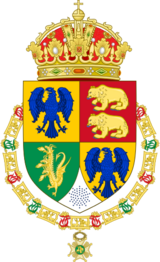
|
Country: Belfras | |
| Type: Heraldic achievement | ||
| Link: Coat of arms of Belfras | ||
| Description: | ||
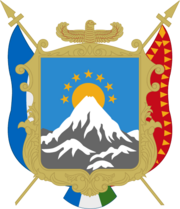
|
Country: Dzhuvenestan | |
| Type: Coat of Arms | ||
| Link: Coat of arms of Dzhuvenestan | ||
| Description: | ||
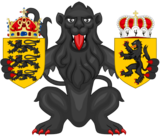
|
Country: Garima | 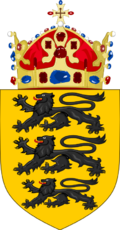
|
| Type: Heraldic achievement | ||
| Link: Coat of arms of Garima | ||
| Description: | ||
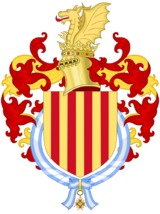
|
Country: Garza | |
| Type: Heraldic achievement | ||
| Link: Coat of arms of Garza | ||
| Description: | ||
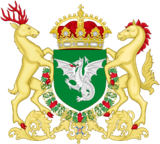
|
Country: Gelonia | |
| Type: Heraldic achievement | ||
| Link: Coat of arms of Gelonia | ||
| Description: | ||
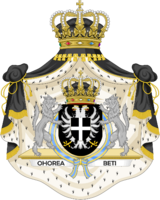
|
Country: Ghant | 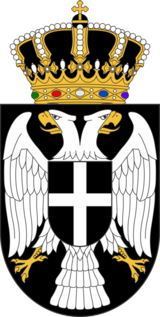
|
| Type: Heraldic achievement | ||
| Link: Coat of arms of Ghant | ||
| Description: The coat of arms of Ghant bears the Ghantish Imperial Coat of Arms as its charge, supported by two white direwolves, known as "Latzotsozuri" (Ghantish: "the White Direwolf"). This is in accordance with Ghantish Imperial Law: The Ghantish nation takes black and white as colors, and as state coat of arms the Imperial Eagle with the motto Ohorea Beti. An imperial decree of 1 December 1800 determined the achievement to be used in the greater and the lesser version, respectively. There is also a middle version of the arms.
The greater arms (pictured to the left) are used for official state purposes. The lesser coat of arms (pictured to the right) are used by the Ghantish Imperial Family and on official sites of the monarchy and of the government. | ||

|
Country: Gristol-Serkonos | 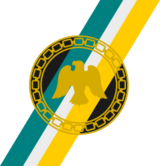
|
| Type: Great Seal | ||
| Link: Coat of arms of Gristol-Serkonos | ||
Description:
| ||
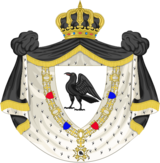
|
Country: Keuland | |
| Type: Heraldic achievement | ||
| Link: Coat of arms of Keuland | ||
| Description: | ||
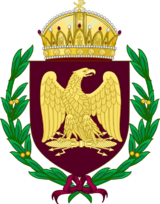
|
Country: Latium | |
| Type: Heraldic achievement | ||
| Link: Coat of arms of Latium | ||
| Description: Purpure an eagle Or, head facing to the sinister, clutching in its talons a Thunderbolt Or. | ||
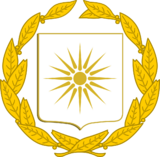
|
Country: Lihnidos | |
| Type: Heraldic achievement | ||
| Link: Coat of arms of Lihnidos | ||
| Description: | ||
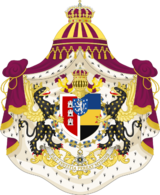 |
Country: Lyncanestria | File:Lesser coat of arms of Lyncanestria.png |
| Type: Armorial achivement | ||
| Link: Coat of arms of Lyncanestria | ||
| Description: | ||
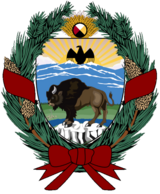
|
Country: Mniohuta | |
| Type: Coat of Arms | ||
| Link: Coat of Arms of Mniohuta | ||
| Description: Prior to 1935 the idea of a coat of arms was largely considered a foreign idea, and in official matters a drum that was used by Spotted Eagle (Gleškáŋblí) as a formal marker of his Chiefdom was used for official matters. An artist from Kanze by the name of Brave lion solder (Ohítigmútȟakíčhita) proposed the current coat of arms as a modernisation effort which after much debate over design passed his nested council and through popular vote was installed as the formal coat of arms of the confederacy later that year. | ||

|
Country: Sudmark | 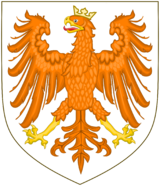
|
| Type: Heraldic achievement | ||
| Link: Coat of arms of Sudmark | ||
| Description: | ||
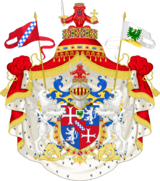
|
Country: Sydalon | |
| Type: Heraldic achievement | ||
| Link: Coat of arms of Sydalon | ||
| Description: | ||

|
Country: Talahara | |
| Type: Sigil | ||
| Link: Lion's paw sigil | ||
| Description: The national emblem of Talahara is the lion's paw sigil: a symbol taken from Talahara's artisanal tradition of tapestry weaving. The lion's paw is a representation of Talahara, drawing from its etymological origin "font of lions", and from its meaning within the symbology of Talaharan tapestry as a sigil of strength and protection. Talaharan tapestries have traditionally been woven with sigils imbuing powers into the finished pieces. These powers are occasionally treated with superstitious reverence, but in the modern era are more commonly regarded as well-wishes. Tapestries with a lion's paw imbue divine protection into a home. Sigils of trees promise easy life and happiness, grains imbue fertility, and bees promote good work. The lion's paw has been associated as a symbol of Talahara since the 9th century CE, but was only officially adopted as a symbol in 1845. | ||

|
Country: Tyreseia | |
| Type: National seal | ||
| Link: Great Seal of Tyreseia | ||
| Description: | ||

|
Country: Wazheganon | |
| Type: National seal | ||
| Link: Federal Emblem of Wazheganon | ||
| Description: The Federal Emblem of Wazheganon is an adapted version of the Banner of Great Norumbia, which featured a black thunderbird on a red banner, used from 1802-1823, which was was adopted by Wazheganon upon the federation's formation in 1823. The symbolism of the thunderbird dates back to the decisive Battle of Tawensony in 1638, which coincided with a strong thunderstorm that was interpreted by the forces of the Wazheganon#Iron Confederacy as divine intervention by mythical thunderbirds. The thunderbird, previously used only by a few prestigious leadership clans, was thereafter used as a seal for the entire confederacy. A blue eight-point star was added behind the thunderbird in 1833 to help differentiate the emblem from several similar designs used by groups throughout northeastern Norumbia. The star was adapted from an earlier glyph, symbolizing unity and the eight major groups which formed the new federation. |
